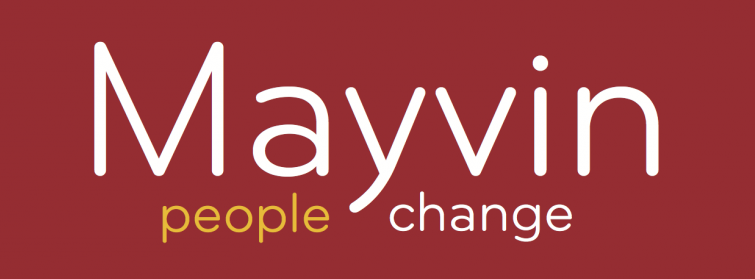In March 2022, Moi Tu 徐 貴 梅 attended Mayvin’s session on Power listening to truth. Following on from the session Moi has very kindly shared her thoughts on the subject in this article, including drawings and the poem featured above. So over to Moi:
The poem on truth is a living poem that I write when encountering difficult stuff. At the time I was triggered by the war unfolding in Ukraine and specifically, the experience of refugees, past and present. It wasn't a trigger response that showed itself in feeling cross and stirred. It was a quiet numbness… a heavier weight in my feet, a tension in my neck. I felt muted as I heard humanity plead into a hardened void. My mind observed: the carousel of ‘truth to power’ spins again
My early relationship with ‘truth to power’ is best described as complicated. I saw myself as someone finding the openings on tightly sealed doors rather than the person shutting them. So it felt painfully uncomfortable, as an adult, to realise this:
there's a voice that exists
in every workplace
every home
and in every one of us:
an authoritative voice that says,
rejected, with no right to appeal
This voice and its impact is not always so obvious.
The more obvious stuff
Let’s take a look at this:

Rules of engagement = the spoken and unspoken norms of communication, specifically in the workplace[1]. Some examples:
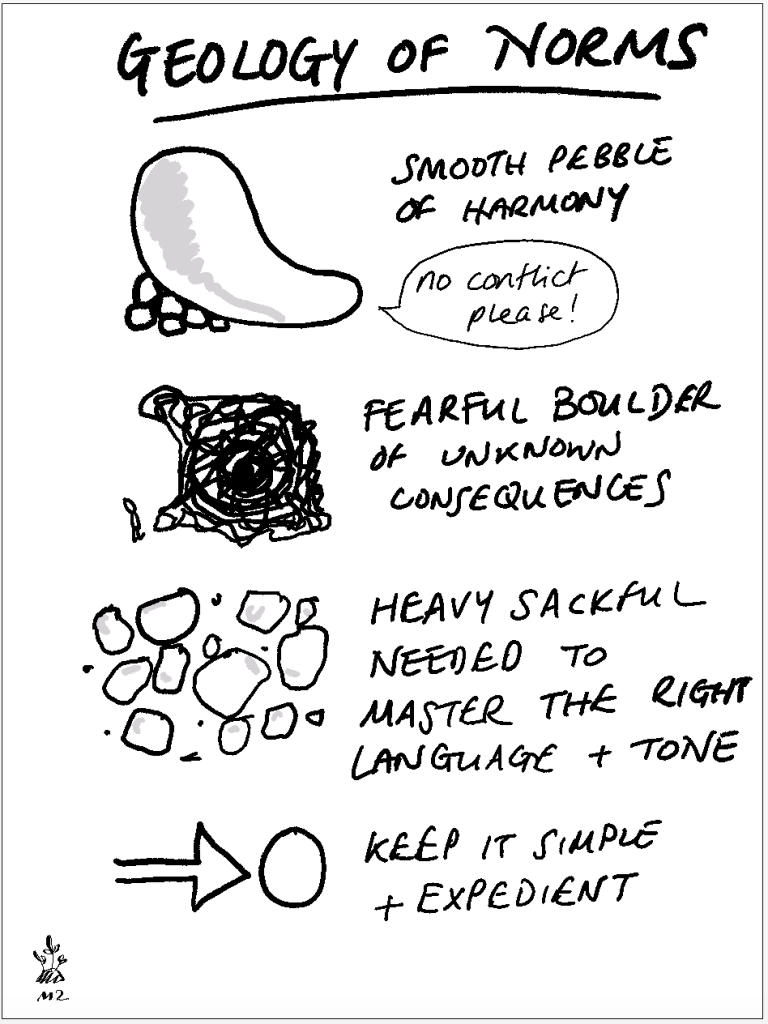
Consider the busyness that diminishes patience and attention. The expediency that squashes out thinking and dialogue. The assault course of acceptable language or word counts/one-pagers that can temper and sanitise truth into palatable white noise. All happening whilst striving for more difference.
So powerful are these norms we inhabit that self-censorship kicks in before speaking:
- The questions we don't ask because they might eject us from our seat at the table. (And because we see it happen even before people get to the table)
- The over-restraint of our emotions for fear of appearing weak, out of control, “hormonal”
We do this despite knowing that our honesty and vulnerability is what helps us get to what's real. And that what we deny we amplify. Yet still, "stop making a fuss" and "no politics or bad vibes at the dinner table".
This kind of self-regulatory or disciplinary power[2] is quietly potent. It's not one that shows itself as faceless memos sealing the red tape. It doesn't wander around with an honest sign flashing "rejected". It’s the art of silencing, or requiring truth to contort itself to be 'heard', without - arguably - knowing.
This might sound cynical, but these norms aren't about baddies and goodies. They have their situational value. I'm trying to highlight something about intentionality:
What do we notice about our norms and ways of working?
…
Why is that? How are they serving us?
What's important to us? And how do we bring that to life in our being and our work?
If we're not more intentional about the stuff we can see, then what happens to the stuff we can't or don't want to see?
The less obvious stuff
Years ago, I was delivering a major change programme to implement new business systems. I was listening to staff, making sure the new systems worked. I loved it.
Our small team created a beautiful project ecosystem: a kanban board that captured everything we heard. There were 80+ open comments/queries from staff at any one time, ranging from corporate decision-making processes through to the devilish naming of data fields on IT systems.
We held and facilitated a messy and rich tapestry of different needs, woven through the big picture and detail. We built trust from translating feedback into dialogue into action. Communication was kept open by asking and meeting people where they were. Feedback from colleagues puffed my ego: I’m a great listener, sense-maker and doer.
Alongside this narrative was the story of "Mr Disruptive", who wanted something different to the plan. We were on a deadline to meet the Programme Board for approval and budget for the next phase of work. His request was deemed ‘out of scope’ so it was duly placed there. I met with him to discuss further and to understand his needs better…
The truth was, I wanted to manage the inevitable 'noise' that would reverberate from him after the Board meeting. I met him with my defence prepared and watertight – I’d tell him that our decision was aiming for better, not perfect; serving the collective, not individual. Words that were more honest and relevant elsewhere.
The outcome was already decided and I disguised this with a performance of listening. It took me a while to realise and admit: I delivered an uninformed rejection with no right to appeal message emblazoned with niceness.
5 years later, it turned out Mr Disruptive Insight was right. A new business case was created to address the exact issue he was raising the alarm about. By then, it was harder to fix due to the hard-baked workarounds that flourished in the wake of not fixing it sooner. I didn’t listen, even with my ‘good’ intentions and it came at a cost.
What did I learn about my listening?
The easy-to-present-truth: my attention span is limited when busyness takes over. Anything that makes that situation uncomfortably worse is inconvenient. I distanced myself from what I didn't want to hear by “doubling-down-and-getting-on-with-the-real-work". Because also, "this is how we do things here".
The harder-to-face-truth: there were other “Mx Disruptives” that were treated as “Mx Insight”, where project specifications and timelines were adjusted from my advocacy and negotiation. Some people didn’t get what they hoped, but were satisfied enough with the rationale or dialogue we had. Why was the outcome different in this story?
Mr Disruptive reminded me of a family guest, pressing the doorbell impatiently as I scurried to the door as a child. I’d then quickly retreat to serve tea, scowling secretly inside. My early memories painted this guest as impatient and demanding. What I felt inside, as an adult relating to Mr Disruptive, yanked at something deeper. I didn’t listen to what he was saying because something felt familiar… I felt annoyed and afraid. My ‘scowl and resist in private’ strategy reflexed in response.
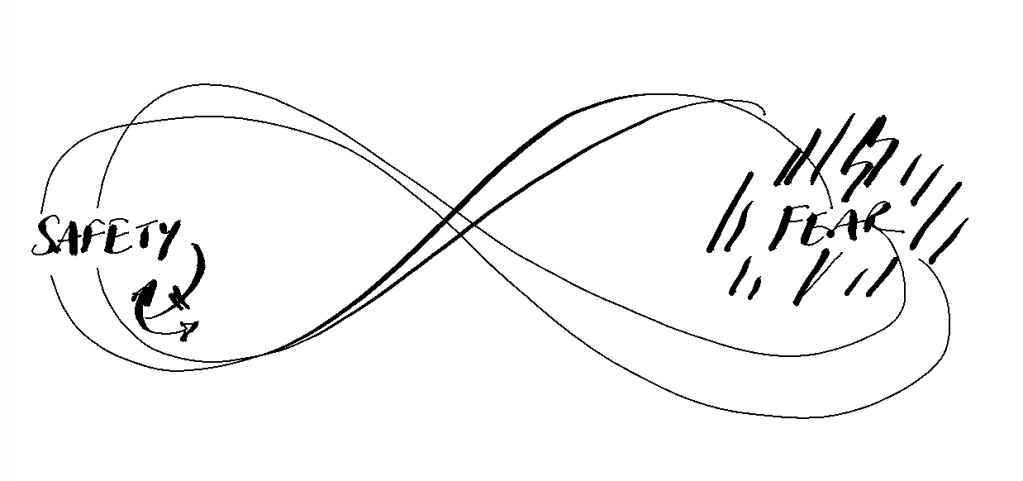
On safety
I notice that I’m sharing a story that feels relatively safe to talk about. It’s a “learning from failure” story that's familiar to every change project out there. It’s relatable to anyone who dislikes the sound of incessant doorbell-pressing. Does my assumed relatability mean I won’t be judged too harshly?
It feels safer also because my personal boundaries around respect were not crossed. Any guilt and shame I felt was buffered by 5 years. By then a trusted colleague helped me to meet my learning with more compassion and honesty.
We say failure is inevitable: accept and learn from it. We say we need more vulnerability: because stepping into what frightens and tenderises us, helps us step into our humanity. And we say we want to hear more truth. And yet here I am, still tiptoeing around the more uncomfortable stories, noticing my own safety thresholds.
These moments remind me of the sensitivity and wide ears needed when we talk about safety to speak, or when "we want this to be a safe place where people can bring their whole selves". In my totally biassed opinion:
I've learnt that it's possible to create conditions for more safety to speak and hear in the workplace. But not conditions where people feel entirely 'safe'.
I believe in striving for cultures where people can - if they choose to - bring their whole selves to work. But there's still a lot of work in figuring out what that means… and if people really want it.
I’ve heard in a number of explorations, ‘safety to speak’ is akin to walking around naked with feelings red-raw on full show. If this is a desired vision (or fear, or both) - then this presents a question for our instrumentality, our leadership practice. What does this mean for the separation needed - in being able to hold up what's messy in front of us and find healthy containment - to be more purposeful with our power? Speaking truth is different from being an entirely open unedited book. I think. (Interestingly, discussions about emotional nudity tend to stay in the ‘curious space’).
‘Safety to speak’ and 'truth to power': what we might think it is, is often different to what we want.
Drawing a wobbly line[3]
Of course, we’re not always dealing with high stakes work. And our individual perceived power may not exercise harm to someone else’s safety.
Hold that last thought…
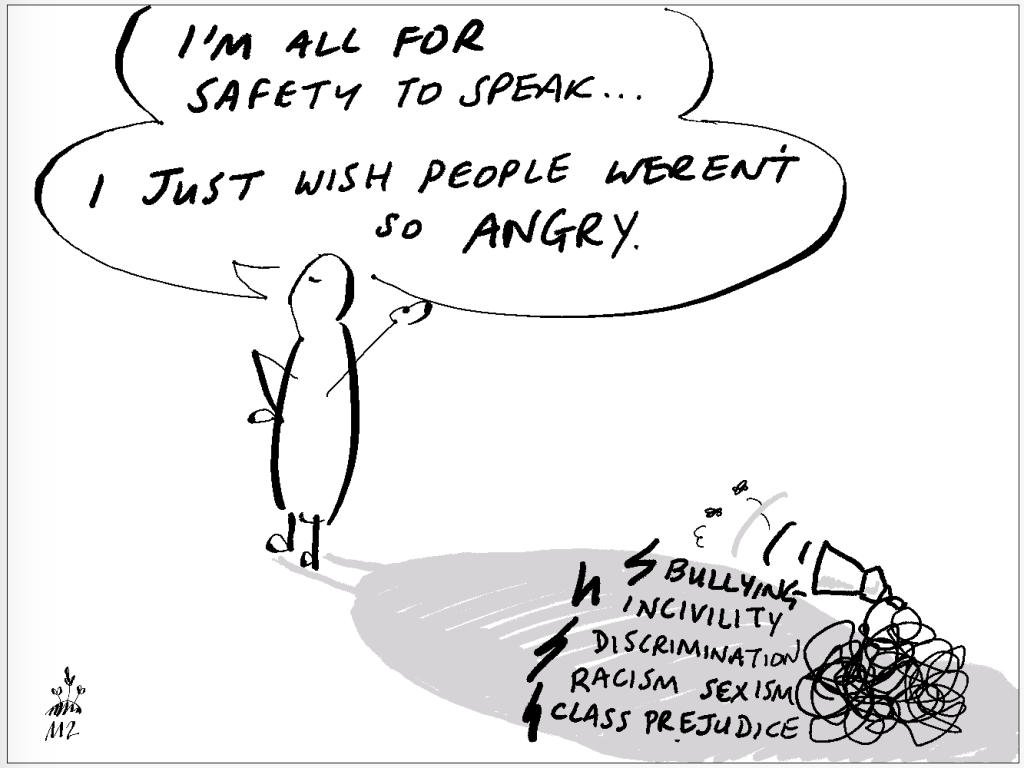
We all have the capability to shut the door on what we can't or don’t want to hear. We do this to ourselves and we do it to others.
And when it comes to these doors and our avoidance or journeys to them, notice: power. Because when it comes to exclusion, safety, and other hot potatoes filled with high emotion and difference: the ground on which we tread is not even. There is inequality hardwired in the work to dismantle inequality. There is closure hardwired in the work to create more open cultures. Awareness and intentionality are precious compasses in our process for change.
Door shutting: call it the ‘fight or flight response’ or many other ways in which we make sense of our behaviours and coping mechanisms. But there’s something resourceful in the personal stories we hold that can help us to respond more honestly and listen better.
Our capacity to hear ebbs and flows with our self-awareness and wellbeing. Without some active attention to this, the work in ‘safety to speak’ and ‘truth to power’ will continue to exhaust itself by speaking into a void.
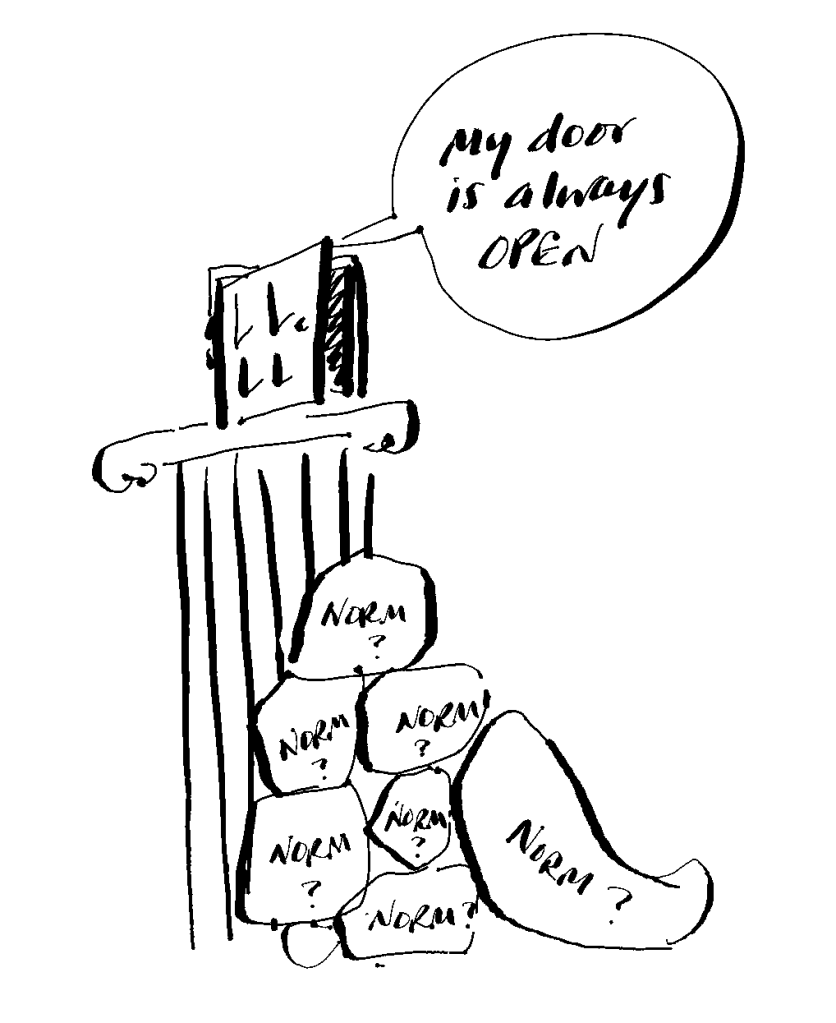
👆Add/edit/scrawl/draw/write/play chess here.
Read, see, listen…
- What's not in the headlines? The art here is breathtakingly beautiful, heartbreaking and haunting:
Book: Who am I? The Story of a London Art Studio for Asylum Seekers and Refugees (2020) - Tania Kaczynski. Extract here and more info: www.newartstudio.org.uk.
In the chapter titled, It’s Never Over, Tania says “I expected graphic representations of burning villages, scenes of battlefields or prisons… But no. It turns out the expression of human experience is much less obvious than that. It is subversive”.
2. I felt relief and recognition listening to this:
Podcast: Leading in an Age of Employee Activism (February 2022) - Megan Reitz & John Higgins in conversation with Brené Brown.
There’s a really interesting section on ways of learning, where John apologises for ‘rambling/going on’ (?), but I wanted to hear more of that impassioned blurt.
3. Song: Our Pathetic Age - DJ Shadow ft. Samuel T. Herring.
[1] Workplace = very much part of the world-wide-web, regardless of mission or differences.
[2] The term ‘disciplinary power’ is borrowed from my reading of Cole, M., 2020. Oxon: Routledge. Radical Organisation Development. Chapters on A Foucauldian Preamble (pp.16-39) and A Genealogy of the Organisationally Developed Workplace (pp.40-73). Much of this resonated with my own experience of doing OD in-house and the need to reflect more deeply about power. I recommend this book.
[3] I’ve shamelessly used the wobbly line since I first heard it from OD Practitioner, Shelly Hossain. She used it very gently and powerfully to bring containment and movement for our group’s learning process on a chewy topic. The wobbly line has been a generative metaphor for me. Long live the wobbly line.
